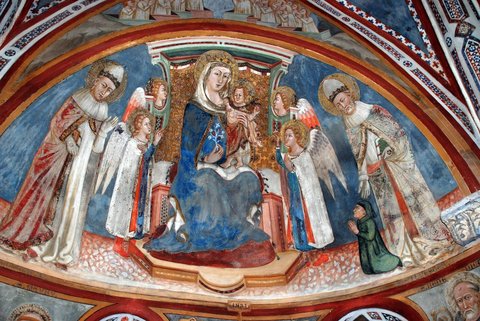So Great a Cloud of Witnesses (XIV)
CHAPTER XIV. How the Night-Office is to Be Said on Saints’ Days
17 Feb. 18 June. 18 Oct.
On the Festivals of Saints, and all other solemnities, let the Office be ordered as we have prescribed for Sundays: except that the Psalms, antiphons and lessons suitable to the day are to be said. Their number, however, shall remain as we have appointed above.
Festivals of the Saints
Saint Benedict distinguishes the festivals of saints from “other solemnities”, presumably those of the Lord. In Saint Benedict’s day there were far fewer festivals of saints than there are in the present liturgical calendar. Saint Benedict’s monks would have known the most ancient festivals of the Mother of God on January 1st and August 15th. They would have celebrated the feast of Saint John the Baptist, of the Apostles, of the greater martyrs and of local ones, and of some confessors such as, for example, Saint Martin of Tours.
Oratories and Relics
Saint Benedict’s first act upon arriving at Monte Cassino in 529 was to destroy the idol and altar that he found in the there in the temple dedicated to Apollo. On that site he built a church dedicated to Saint John the Baptist and an oratory dedicated to Saint Martin of Tours. This indicates that Saint Benedict already celebrated the liturgical cultus of these two monastic saints. Saint Benedict’s liturgical devotion to the saints appears in Chapter LVIII, on the reception of new brethren, where he alludes to “the saints whose relics are in the altar.”
Ordering the Night Office
Saint Benedict orders that the Night Office of the festivals of saints be celebrated with proper psalms, antiphons, and lessons, while keeping the order established for Sundays. This detail reveals a keen sensitivity to the liturgical cultus of the saints, and to the already high development of the choral Office celebrated by Saint Benedict and his monks.
With the progressive enrichment of the sanctoral cycle, it became necessary to devise various ways of ranking the festivals of saints, and of ordering their celebration. Over time this gave rise to the current practices by which certain greater festivals are marked by a complete proper Office, or by one taken from the Common suited to the particular saint, whereas on other days, only the invitatory antiphon, hymn, lesson, responsory, and collect would be of the saint.
In the Wake of the Second Vatican Council
In many places in northern Europe —notably in France, Germany, Belgium, and the Netherlands— a certain Protestantisation crept into the liturgical sensibility prevalent during the years following the Second Vatican Council. This led to a suspicion of the cultus of the saints, their festivals, and their relics, and to a trend towards minimizing the role of the saints in Catholic life, and towards diminishing as much possible their place in the liturgy. This trend was fostered by the unfortunate introduction of so-called “optional memorials”, by which certain saints were condemned to liturgical oblivion. It is a principle, easily observed in the recent history of the liturgy, that as soon as something is declared optional, it falls into desuetude.
Sentire Cum Ecclesia
It is noteworthy that Saint Ignatius of Loyola, in his sixth rule for holding fast to the sentiments of the Church (sentire cum ecclesia) recognized the threat of Protestant hostility to the cultus of the Saints and to Catholic piety, and so wrote: “To praise relics of the Saints, giving veneration to them and praying to the Saints; and to praise Stations, pilgrimages, Indulgences, pardons, cruzadas, and candles lighted in the churches.”
The Companionship of the Saints
An authentic Benedictine piety delights in the cultus of the saints, of their relics, and of their altars. I remember being moved, in my monastic youth, by the simple devotion of monks who, either before Matins or after Compline, would go, as it were, in pilgrimage, from altar to altar, and from image to image, honouring the saints and seeking their intercession. “And therefore we also having so great a cloud of witnesses over our head, laying aside every weight and sin which surrounds us, let us run by patience to the fight proposed to us: looking on Jesus, the author and finisher of faith, who having joy set before him, endured the cross, despising the shame, and now sitteth on the right hand of the throne of God” (Hebrews 12:1-2).


Dear Father Mark,
There’s a definitive “liturgical oblivion” around here. John the Baptist doesn’t get a special(?) mass on June 24. But then, our Lord is not treated much better.
I can say with St. Therese of Lisieux, “Do you know my Sundays and festivals? They are the days when the good God tries me the most”.
The Lord still “crowns the year with His goodness” so why have the Holy days become so ordinary?!
(Agnieszka)
Father Mark,
Just had to comment on this, I agree with what has been said in the article and by Agnieszka’s comment. It appears to me, there has developed a minimalist approach. The transfer of Solemnities of the Lord on Holy Days of Obligation to the Sunday, as here in England and many other countries, was a retrograde step. Noticeable here, St. Alban, Protomartyr of England as in the Breviary, is a Memoria in the National Calendar, at sometime in the past, that I have to confess escapes me, it was demoted to an Optional. All very sad and just an example of many but is in my mind because it was duly celebrated yesterday, the 20th June. Needles to say, in my Divine Office, I raised him up!